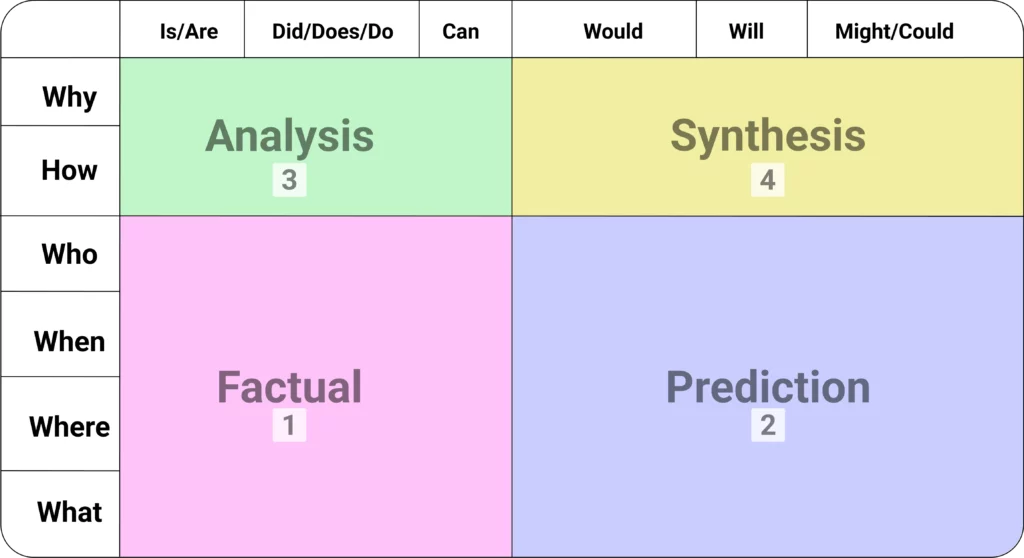Tips for Creating Questions
- Open-Ended: Use open-ended questions or writing prompts (see image below) to develop students’ writing ability and content knowledge in Short Answer. Phrases like “Explain why…,” “Describe how…,” or “What do you think about…?” will be helpful. For more sentence stems, download our question stem guide. Use the stems from boxes 2, 3, and 4. If you want to test fact based recall, you can use stems from box 1, but students will struggle to compare the types of responses these questions elicit. If you want to do fact based questions, pair them with sentence stems from boxes 2, 3, or 4. For example, instead of asking “Who was the first president of the United States?” ask “Who was the first president of the United States and how did they influence the development of the American presidency?”
- Objective First: Begin by asking yourself what you want students to demonstrate or achieve through their answers.
- Be Specific: While you want questions to be open-ended, being too vague can confuse students. Guide their thinking with specifics. For example, instead of “Describe a scene from Chapter 5” ask “Describe a scene from Chapter 5 where a character faced a moral dilemma.”
- Foster Personal Connections: Questions that allow students to relate content to their own experiences can be very powerful. E.g., “How does this historical event relate to something in today’s world?”
- Promote Critical Thinking: Encourage comparison: “Compare and contrast the main character’s motivations.” Ask for evaluation: “Evaluate the author’s argument in the third chapter.”
Tips for Creating Feedback Criteria
The feedback criteria should describe the specific aspects you want students to include in an ideal response. Things to keep in mind:
- Align with Lesson Objectives: Criteria should align with the focus of your lesson. For example, if the lesson focused on persuasive techniques, the feedback criteria might focus on the use of evidence or rhetorical devices. “Provides multiple evidence-based claims” would be a great feedback criterion for this.
- Maintain positive orientation: Feedback criteria should describe the positive aspects that should be present in an ideal response. Avoid negative criteria like “missing vocabulary words” or “unclear topic sentence”. Replace them with positive criteria like “strong use of lesson vocabulary” or “clear topic sentence.”
- Comparative terms are helpful, but not necessary: You can include comparative words like “better”, “stronger”, or “more…” in your criteria to provide clarity in the comparative feedback process, but these terms are not required. For example, you could have a criterion of “more creative”, but you could also just say “creative”. Students will then decide, of the two responses on their screen, which one is more creative. (they must pick one – there are no “neither” or “both” options)
- Limit the number of Criteria: 1 to 3 feedback criteria per question or writing prompt is ideal. More than 5 can become a bit monotonous for students. Prioritize the most essential aspects of a strong response.
Preview how it will work in Short Answer...
Adam Sparks
Adam taught social studies and English in Nebraska, Chicago, and China for 7 years and holds a master's in Learning Design and Technology from Stanford. His work focuses on improving K-12 formative assessment through peer feedback. He is the cofounder of Short Answer. Follow him on Twitter @mrsparkstweets








